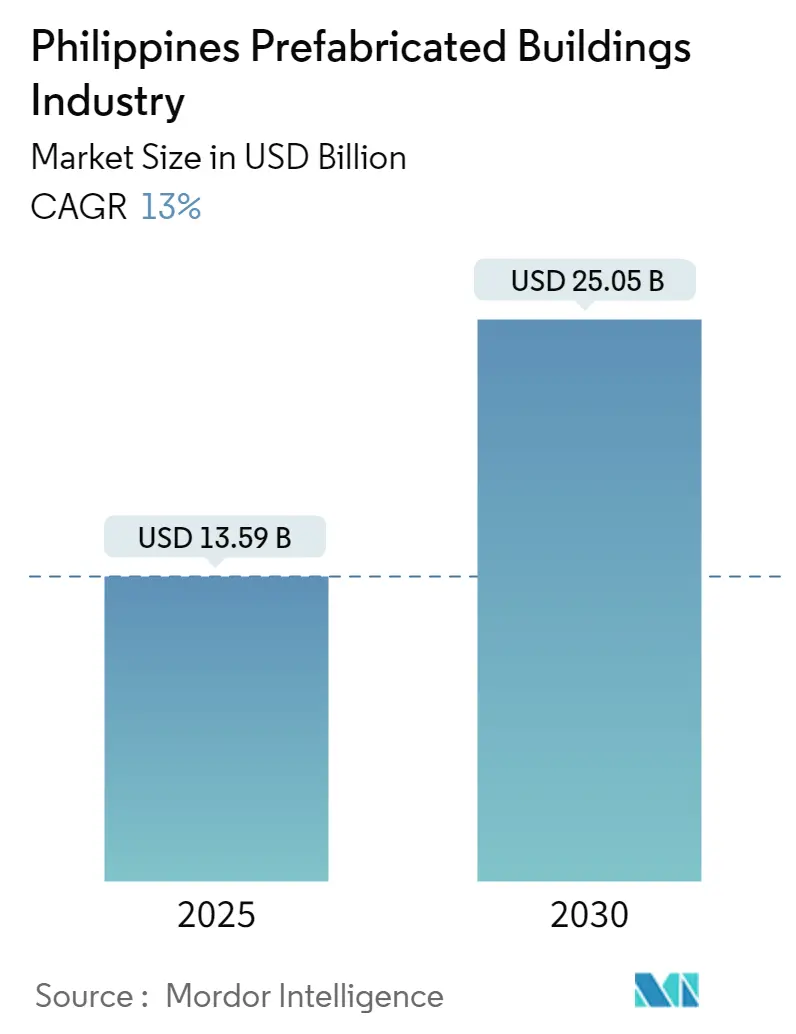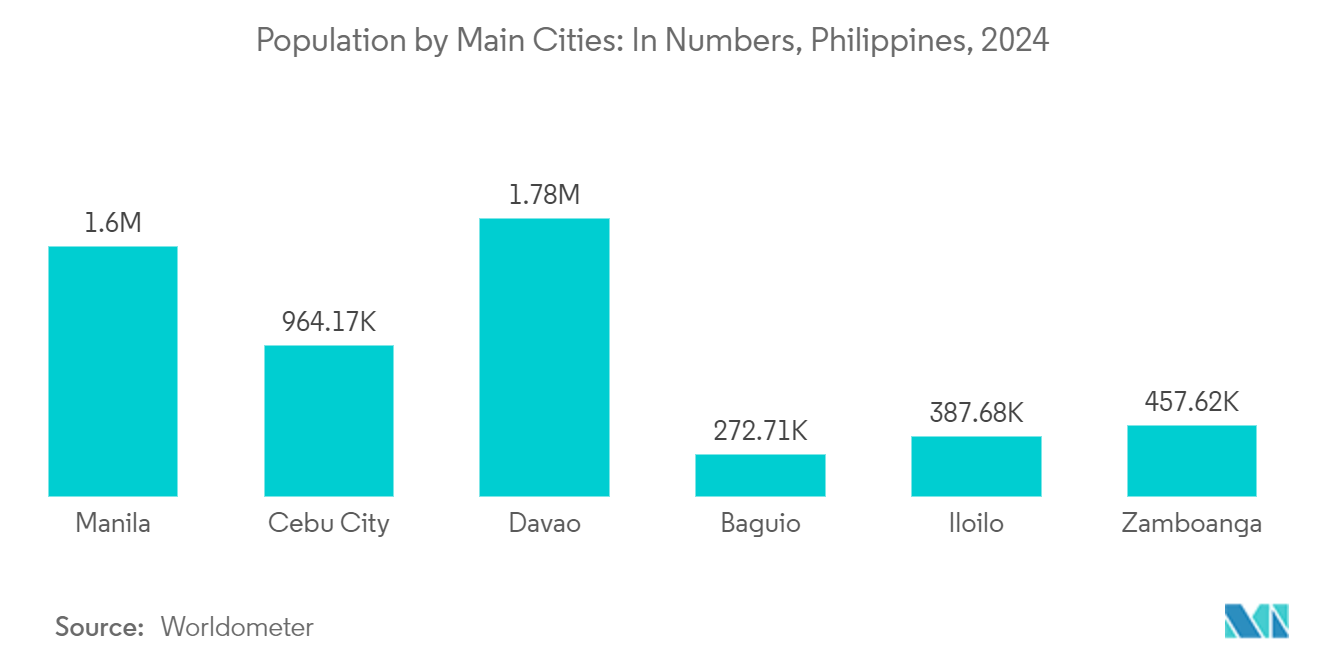
Philippines Prefabricated Buildings Industry Market Analysis
The Philippines Prefabricated Buildings Industry is expected to grow from USD 13.59 billion in 2025 to USD 25.05 billion by 2030, at a CAGR of 13% during the forecast period (2025-2030).
- The demand for prefabricated buildings in the Philippines is reportedly increasing due to the government's focus on infrastructural developments. Initiatives such as the National Housing Authority are said to be driving housing demand, which in turn is boosting the need for prefabricated structures. Construction activities in key cities are believed to be attracting multinational corporations (MNCs) to acquire commercial spaces, as the country continues to serve as an outsourcing destination for global firms. This trend is reportedly creating a ripple effect on related industries, including the flooring sector.
- According to reports from January 2024 by Phillstar Global, the Department of Human Settlements and Urban Development (DHSUD) has expressed optimism about achieving significant milestones in the coming year. The implementation of a national housing program is expected to benefit from credit lines that would enable the National Housing Authority (NHA) and the Social Housing Finance Corporation (SHFC) to develop and construct over 11,000 housing units.
- World Bank blogs in February 2024 have highlighted that the Philippines is at a critical stage in its urbanization process. By 2050, it is estimated that the urban population could nearly double to 102 million. Local Government Units (LGUs) are reportedly implementing smart city solutions, which are seen as a positive development for the prefabricated buildings sector in the country.
- Advancements in precast innovation and dimensional accuracy are said to be enabling planners and architects to design high-quality and innovative developments. Sustainable features are reportedly being incorporated into these designs, with many prefabricated buildings receiving certifications such as Leadership in Energy and Environmental Design (LEED), Building for Ecologically Responsive Design Excellence (BERDE), Excellence in Design for Greater Efficiencies (EDGE), and the WELL Building Standard, further strengthening the preference for prefabricated structures.
- The prefabricated building market in the Philippines is reportedly divided into two main categories: low-rise and high-rise buildings. Low-rise structures are said to include townhouses, single-family homes, and low-rise apartment buildings, while high-rise buildings reportedly consist of mid-rise and high-rise apartments, as well as commercial and institutional structures.
Philippines Prefabricated Buildings Industry Market Trends
Rapid Urbanization Driving the Growth of the Market
The Philippines has been experiencing rapid urban expansion, with its population reaching 116.3 million and an annual growth rate of 0.83% as of December 2024, according to Worldometer's analysis of the latest UN data. Approximately 56.4 million people now reside in urban areas. This urbanization has reportedly led to a shortage of residential and commercial spaces, with traditional construction methods often unable to meet the growing demand. Prefabricated buildings have been identified as a practical and cost-effective solution to address these challenges, gaining significant traction in the country.
The rising demand for affordable housing has been highlighted as a key factor driving the prefabricated buildings market in the Philippines. With urban centers expanding and the population increasing, the need for economical and quickly constructed housing has become critical. Prefabricated buildings are said to offer a more affordable and faster alternative to conventional construction methods, which is particularly important in a country where many individuals face difficulties in accessing affordable housing options.
Additionally, the Philippines' susceptibility to natural disasters such as earthquakes and typhoons has reportedly increased the demand for resilient structures. For example, an earthquake off eastern Mindanao on August 3, 2024, was linked to the movement of an extinct fracture zone, as reported by Temblor. Prefabricated buildings are often described as being more resistant to such disasters compared to traditional structures. Their design, which incorporates flexibility and shock absorption, is believed to make them more durable in disaster-prone areas, addressing a critical need in the Philippines where natural calamities frequently damage infrastructure.
In conclusion, the growing urbanization, demand for affordable housing, and the need for disaster-resilient structures are driving the adoption of prefabricated buildings in the Philippines. These structures are emerging as a viable solution to the challenges posed by rapid urban growth and the country's vulnerability to natural disasters.

Increasing Demand for Prefabricated Commercial Spaces
The growing demand for commercial spaces in the Philippines is reportedly driving the expansion of the prefabricated buildings market. Industry sources suggest that the country's rapid economic growth, coupled with an increasing number of companies and startups, has significantly boosted the need for efficient construction solutions. Reports from the Industry Association indicate that expansions and new setups accounted for 70% of transactions by Q3 2023, with the net take-up for 2024 projected to reach 300,000 sq.m., reflecting a 36.4% increase compared to 2023. Prefabricated buildings are being recognized as a cost-effective and time-efficient alternative to traditional construction methods, addressing the rising demand for commercial infrastructure.
It has been observed that the retail and hospitality sectors are the primary drivers of this demand for prefabricated commercial spaces. According to The Travel and Tour World, Philippine property developers have reportedly invested approximately PHP 250 billion (USD 4.25 billion) in the hospitality sector, aiming to construct over 40,000 new hotel rooms. The retail industry, fueled by the increasing purchasing power of the middle class, is also contributing to the demand for prefabricated retail spaces, particularly in urban areas. Data from the Philippine Accommodation Pipeline Report indicates that upcoming developments are expected to add 40,084 new room keys, reflecting a strong response to the growing need for lodging in key tourist destinations. Additionally, the steady rise in tourist arrivals has reportedly led to a surge in demand for prefabricated hotels and other hospitality structures.
In conclusion, the Philippines' prefabricated buildings market is experiencing significant growth, driven by the increasing need for commercial spaces in sectors such as retail and hospitality. As businesses and developers continue to seek cost-effective and efficient construction solutions, the market is expected to maintain its upward trajectory in the coming years.

Philippines Prefabricated Buildings Industry Industry Overview
The Philippines prefabricated buildings industry is fragmented in nature, with none of the major players having a significant share to influence the market. The prefabricated and building industry is also embracing technology at a faster pace. Owing to this, construction companies are partnering with technology startups to increase productivity and efficiency. Compared to other countries, the Philippines has fewer companies in prefabricated building construction, such as iSteel Inc, USG Boral Building products, Frey - Fil Corporation (FFC), Revolution Precrafted and Smarthouse Corporation etc., also, providing an opportunity for new players to enter the market with less competition and introduce new prefabricated building structures.
Philippines Prefabricated Buildings Industry Market Leaders
-
iSteel Inc
-
USG Boral Building products
-
Frey - Fil Corporation (FFC)
-
Revolution Precrafted
-
Smarthouse Corporation
- *Disclaimer: Major Players sorted in no particular order
Philippines Prefabricated Buildings Industry Market News
- November 2024: The Las Piñas city government has started constructing prefabricated housing units to provide shelter for 161 informal settler families (ISFs). These prefabricated units, known for their cost-effectiveness and faster construction timelines, are being built at the Green Archers Compound in Barangay Pulanglupa Uno. The project is reportedly part of the second phase of a housing program initiated two years ago, in collaboration with the National Housing Authority (NHA), the Social Housing Finance Corp. (SHFC), and the city's Local Housing Development Office.
- October 2024: The National Housing Authority in the Davao region (NHA 11) has implemented prefabricated building projects worth PHP 500 million (USD 8.50 million) from 2022 to October 2024. These projects have resulted in the construction of 3,073 units, with 1,950 units reportedly allocated for indigenous peoples (IPs). The use of prefabricated buildings highlights the growing adoption of cost-effective and efficient construction methods in the Philippines, addressing housing needs in a timely manner.
Philippines Prefabricated Buildings Industry Industry Segmentation
A prefabricated building is a building or part of a building that has been manufactured in advance and can be easily transported and assembled.
The Philippine's prefabricated buildings market is segmented by material type (concrete, glass, metal, timber, and other material types) and by application (residential, commercial, and other applications). The report offers market size and forecasts for the Philippines prefabricated buildings industry in value (US) for all the above segments.
| Material Type | Concrete |
| Glass | |
| Metal | |
| Timber | |
| Other Material Types | |
| Application | Residential |
| Commercial | |
| Other Applications (Industrial, Institutional, and Infrastructure) |
Philippines Prefabricated Buildings Industry Market Research FAQs
How big is the Philippines Prefabricated Buildings Industry?
The Philippines Prefabricated Buildings Industry size is expected to reach USD 13.59 billion in 2025 and grow at a CAGR of 13% to reach USD 25.05 billion by 2030.
What is the current Philippines Prefabricated Buildings Industry size?
In 2025, the Philippines Prefabricated Buildings Industry size is expected to reach USD 13.59 billion.
Who are the key players in Philippines Prefabricated Buildings Industry?
iSteel Inc, USG Boral Building products, Frey - Fil Corporation (FFC), Revolution Precrafted and Smarthouse Corporation are the major companies operating in the Philippines Prefabricated Buildings Industry.
What years does this Philippines Prefabricated Buildings Industry cover, and what was the market size in 2024?
In 2024, the Philippines Prefabricated Buildings Industry size was estimated at USD 11.82 billion. The report covers the Philippines Prefabricated Buildings Industry historical market size for years: 2019, 2020, 2021, 2022, 2023 and 2024. The report also forecasts the Philippines Prefabricated Buildings Industry size for years: 2025, 2026, 2027, 2028, 2029 and 2030.
Our Best Selling Reports
Philippines Prefabricated Buildings Industry Industry Report
Statistics for the 2025 Philippines Prefabricated Buildings Industry market share, size and revenue growth rate, created by Mordor Intelligence™ Industry Reports. Philippines Prefabricated Buildings Industry analysis includes a market forecast outlook for 2025 to 2030 and historical overview. Get a sample of this industry analysis as a free report PDF download.




